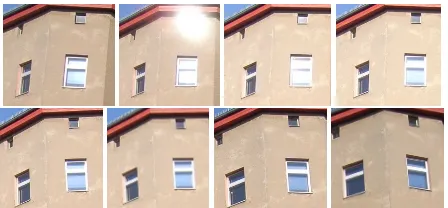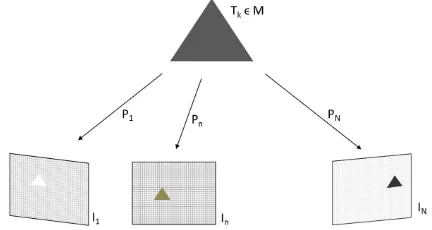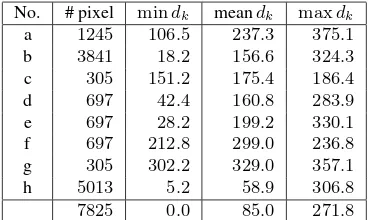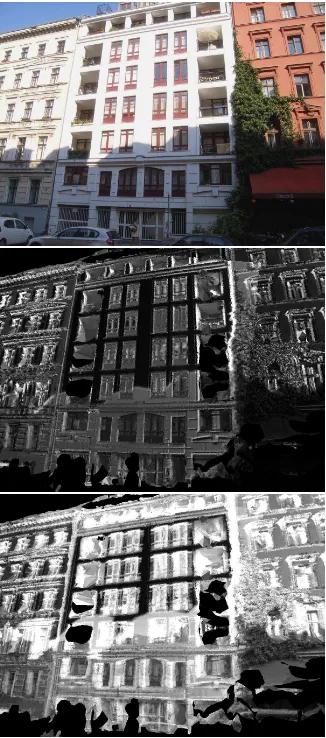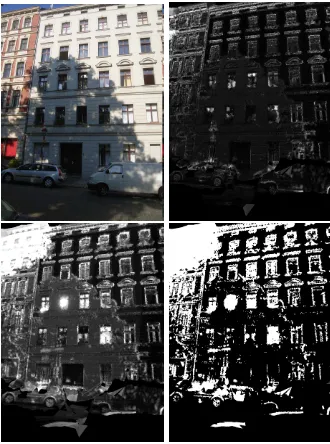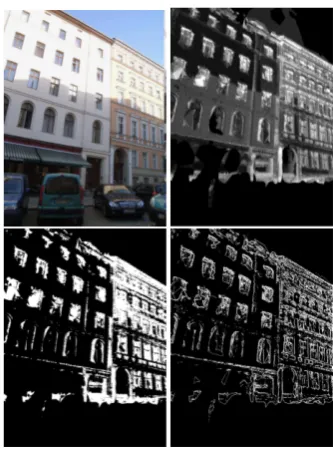THE POTENTIAL OF SPECULAR REFLECTIONS FOR FAC
¸ ADE IMAGE ANALYSIS
M. Drauschkea,b∗, H. Mayerb
a
German Aerospace Center, Institute of Robotics and Mechatronics, Perception and Cognition, Oberpfaffenhofen, Germany b
Bundeswehr University Munich, Institute of Applied Computer Science, Visual Computing, Neubiberg, Germany [email protected] - [email protected]
WG III/4
KEY WORDS:Fac¸ade Images, 3D Reconstruction, Reflection Analysis, Window Detection
ABSTRACT:
Several approaches for window detection have been proposed in recent years, which all use the window size, shape or position within the fac¸ade as characteristics for the detection. In this paper another property of windows is proposed for their detection: Windows are made of glass, so they tend to specularly reflect sun light, while the surrounding wall diffusely reflects it. To this end, colour values in multiple views are analysed to detect specular reflections. In the experiments, walls often show a high homogeneity of small colour differences, and many windows are clearly visible in the form of colour differences. Nevertheless, it is difficult to segment windows from the fac¸ade if there is no prior knowledge about the intensity of the scene’s illumination. Promising results are obtained if the fac¸ade lies in the shadow, e.g., of another building or a tree.
1. INTRODUCTION
Window detection and extraction from images or point clouds is a very active research field in photogrammetry and computer vision. When inspecting only images, windows often show a big contrast to their surrounding, the masonry. Thus, edges and corners of windows can sufficiently be detected. E.g., (Lee and Nevatia, 2004) detect windows based on cumulative gradients in rectified images, and in (Reznik and Mayer, 2008) candidates for windows are found using an implicit shape model. While the first approach relies on horizontally and vertically aligned win-dows, the second approach uses the window alignment to deter-mine consistent window parameters for a fac¸ade.
Another way of describing windows namely as aggregate of sub-structures is employed in ( ˇCech and ˇS´ara, 2009) considering two characteristics: the darkness of window panes in comparison of the surrounding window frames as well as the compositional struc-ture of fac¸ades. Again, rectified views and the grid strucstruc-ture of windows are essential for the success of the approach. Perspec-tive views have been used as input in (Ali et al., 2007), where windows are detected on the basis of their texture. Although, such image-based approaches produce good results on (rectified) down-town fac¸ades, they obviously have problems with occlu-sions, strongly perspective views or strongly textured or deco-rated fac¸ades. Moreover, many windows to rooms in the cellar or attic are often missed by the approaches above, because they are usually very small.
When working with point clouds from laser scanning, windows often reflect or absorb the light ray, so point clouds typically con-tain no points at window positions. This fact is used for extract-ing windows in, e.g., (Pu and Vosselman, 2007)or (Wang et al., 2011). If a point cloud has points at windows, e.g., because it has been reconstructed by dense image matching, then these points lie behind the fac¸ade plane. Consequently, the relative position of windows with respect to the fac¸ade’s surface is often used for window detection, e.g., (Tuttas and Stilla, 2013), (Aijazi et al., 2014) or (Nguatem et al., 2014). Here again, the alignment of
∗Corresponding author.
windows in a regular grid is often used to obtain consistent pa-rameters.
In contrast to these approaches which detect windows locally, there also exist various methods for deriving a description of the whole fac¸ade. Particularly, the presence of windows is verified by analysing colour and geometrical features, e.g., (Ripperda and Brenner, 2006) or (Becker and Haala, 2008). Analogue to ( ˇCech and ˇS´ara, 2009), colour features and context information from the spatial arrangement of fac¸ade parts are important for inter-preting fac¸ades, as shown by recently proposed approaches for deriving fac¸ade descriptions from orthographic projections, e.g., (Martinovic et al., 2012) or (Teboul et al., 2013). Here, the con-structed rules for deriving a fac¸ade description highly depend on the building styles and perform very well as long as the fac¸ades have a homogeneous appearance and structure.
Various methods have been proposed in the cited work above us-ing several types of data such as images as well as point clouds from matching or laser scanning. They all have in common that they consider properties of windows that are described in archi-tectural guides, e.g., (Fletcher, 1905). For architects, windows are described as openings of the masonry, which are used for air and light supply of the building’s rooms, and their size, shape, position and the grouping within the wall are very important for the visual appearance of the entire fac¸ade.
Yet, one important characteristics is missing in such architectural descriptions, or it is only implicitly mentioned: Window panes have almost always a planar surface, which consists of translucent and mirroring glass. Consequently, windows may show an other reflection behaviour than the surrounding masonry, cf. Fig. 1. Windows may reflect light like a mirror, i.e., specular reflections may occur, and the masonry normally reflects light diffusely, i.e., its colour changes less.
Figure 1. Eight different views of four windows of one fac¸ade. While the colour of pixels showing the surrounding masonry only changes slightly, the brightness of pixels of the window panes can vary a lot, especially when specular reflections occur.
building scenes, there is one dominant light source, namely the sun, yet there is also ambient light due to diffusion processes in the atmosphere and due to interobject reflections. Because of its complexity, the illumination of the scene is not explicitly mod-elled in this work. This also refers to the light intensity and its absorbed portion at different surfaces.
A further assumption concerns the smoothness of the building surfaces. The visual appearance of buildings and their parts is assumed to change as less than the appearance of vegetation. In aerial images vegetation may show the illuminated surfaces in one view and the shadow side in another. Due to the smoothness of building surfaces, this effect does usually not occur strongly in fac¸ade images.
This paper is organised as follows. In the next section, the re-lated work on analysing reflections is summarised and discussed with a focus on the detection of specular reflections. In Sec. 3, the derived approach for reflection analysis is presented. Exper-iments are described in Sec. 4, which also includes the presenta-tion and discussion of the results. In the last secpresenta-tion, the potential of analysing reflections is summarised and an outlook on further work concludes the paper.
2. RELATED WORK ON REFLECTION MODELLING AND DETECTION
In optics and computer graphics, the appearance of matte surfaces only depends on the pose of the surface and the direction to the illuminating light and it is modelled using the Lambertian or co-sine law. Hence, the intensity of the reflected light calleddiffuse reflectionis proportional to the cosine of the angle between the surface’s normal vector and the vector to the light source. I.e., a diffusely reflecting surface appears equally bright from different view points. In contrast to diffuse reflections,specular reflec-tionsdo not spread the reflected light in all directions, but perfect mirrors keep all light together, reflecting it in only one direction.
In reality, most surfaces are neither a perfect mirror nor a perfect diffuse reflector, they show a combination of both types. Con-sequently, both reflection types are mixed in computer graphics, where the modelling of surface reflections, interobject reflections and the illumination are the task for rendering synthetic images. Several methods for modelling reflections as combinations of dif-fuse and specular reflections have been proposed, e.g., (Phong, 1975), (Cook and Torrance, 1982) or (Ward, 1992). Additionally, detailed models for bidirectional reflectance distribution func-tions (BRDF) have been proposed. I.e., the radiance of a syn-thetic pixel depends at least on the direction of the illuminating light because its intensity gets partially reflected and absorbed, also the viewing direction on the surface point.
Recently, (Schwartz et al., 2014) presented their experimental set-up for determining BRDFs of small objects from images, simul-taneously acquired in a half-spherical dome of cameras. Unfortu-nately, this approach is not applicable to fac¸ade analysis, and it is not convincing that the BRDFs of fac¸ades and window panes can be modelled by adopting BRDFs of bricks, plaster and flinders of glass observed in a laboratory environment.
Considering computer vision, real images show the effects of il-lumination and reflections, e.g., by specular highlights or shad-ows. Specular reflections are clearly visible in images, because they lead to bright image pixels in certain views, even if the sur-face colour is dark. Sometimes images also show the effect of blooming, if the radiosity of the reflected light is too large and also neighbouring pixels show large brightness. (Healey and Bin-ford, 1988) reconstruct cylindrical object surfaces from resulting elongated specular reflections. It is one of the first works, where geometrical and optical analysis were combined.
Videos of building scenes from static webcams have been anal-ysed, e.g., by (Sunkavalli et al., 2007). In such multi-temporal image sequences, the illumination changes only depend on the position and brightness of the sun light. In their experiments, (Sunkavalli et al., 2007) present nearly constant intensity values for pixels in the shadow and significantly higher values with a larger variance for pixels showing directly illuminated building surfaces. All intensity profiles of an image are used to segment shadow areas and then the contributions of ambient illumination from the sky and direct illumination from the sun are determined.
In (Klinker et al., 1990) the colour distribution is analysed and the distribution of pixels showing diffuse reflections is estimated as well as the distribution of pixels showing specular reflections. Both distributions can be bounded by cylinders in colour space, forming a skewed ”T”. In further analysis the colour distribution of diffuse reflections has been in focus, and the potential of the approach is demonstrated for imagery acquired in a controlled environment, i.e., in a laboratory. Considering outdoor images, especially fac¸ade images, this approach seems not applicable, be-cause the colours of pixels showing diffuse reflections cannot be bounded by a slim cylinder, but they have a more complex distri-bution. Consequently, the detection of specular highlights seems to be more promising.
If the view point changes slightly, the position of the specular highlights also moves slightly in the acquired images. The trajec-tories of highlights has been analysed in (Oren and Nayar, 1996), observing a shiny, metallic sphere from different directions. Re-cently, specular reflections of more complex metallic surfaces have been analysed in (Herbort and W¨ohler, 2012). In the pro-posed algorithm, active range scanner data and image-based in-formation are combined to obtain reconstructions also fulfilling the constraints of the reflection model.
image analysis, because too many bright objects such as clouds and white fac¸ades are also segmented as specular highlight.
(Lee and Bajcsy, 1992) analysed the spatial expansion in colour space for diffuse and specular reflections in two views. Since dif-fuse reflections appear nearly equal from different view points, all pixels showing diffuse reflections have the same colour distri-bution over both images. In contrast, pixels with specular reflec-tions have a colour which only appears in one image, and thus, these pixels can be separated from the others. Yet if both images show specular reflections, this approach fails. It has been adopted to multiple views in (Lin et al., 2002). There, the comparison of colours is not performed over all pixels of other views, but along the epipolar lines.
In this paper, the idea of integrating the relative orientation be-tween the multiple views is extended by additionally consider-ing the reconstructed object surface. Image sets are first rela-tively oriented (Mayer et al., 2012). Secondly, dense point clouds are obtained from semi-global matching (SGM) (Hirschm¨uller, 2008) and multi-resolution range data fusion (Kuhn et al., 2013). Last, surface models are derived employing (Bodenm¨uller, 2009). Thus, the 3D geometry of the approximated surface can be con-sidered for analysis of reflections as well as the corresponding image intensities.
3. DETECTING SPECULAR REFLECTIONS IN MULTI-VIEW COLOUR IMAGES
LetInwithn= 1, . . . , Nbe theN fac¸ade images,Pnthe
cor-responding projection matrices, andM the reconstructed mesh model, consisting ofK trianglesTk withk = 1, . . . , K. The
mesh does not need to be water-tight, so it may and will have holes caused, e.g., by occlusions or opened windows or doors. In Fig. 2, the relation between the images and the reconstructed scene represented by a single triangle of the mesh is sketched.
Figure 2. Sketch of a scene with a reconstructed mesh repre-sented by triangleTk ∈ M and three views. The brightness of
the projected triangle varies in all three images from white (I1)
to black (IN).
Furthermore, letXk1,Xk2andXk3be the three 3D-points which
span triangleTk. The three points are visible in imageInat pixels
xnk1,xnk2andxnk3with
xnki=Pn·Xki, i= 1,2,3, (1)
if there is no occluding triangle in between. The z-buffer algo-rithm as presented in (Foley et al., 1996) is used to enforce this visibility constraint. Almost always, the pixelsxnkiare disjunct
for differenti, and often they are also not adjacent. Hence, trian-gleTkis visible in all pixels intersecting the convex hullHnkof
the three pixelsxnk1,xnk2andxnk3. All image pixels which do
not relate to any triangle of the mesh are not further considered for the reflection analysis. Thus, reflections from moving objects such as cars and objects out of the depth range such as clouds are not analysed.
All images were taken with a Ricoh Caplio 500SE camera with a fixed focal length of 5.8 mm. The image sequences were orig-inally acquired for 3D reconstruction (Mayer et al., 2012) and functional modelling (Nguatem et al., 2014). Since a normaliza-tion of intensity values is not necessary for both approaches, the exposure time had not been fixed. So, small intensity corrections might have been performed automatically.
Letcnk be the average RGB colour vector of all pixelsxnkiin
Hnk. I.e., triangleTkhas colourcnkwhen viewed in imageIn. If
Tkis occluded in imageInas determined by the visibility
analy-sis above, then there is no colourcnkavailable. The colour
differ-ence for triangleTkcan be determined by comparing the colour
over all images where it is visible obtaining
dk= max m6=n||(c
mk, cnk)||2, (2)
where||.||2represents the Euclidean distance between both colour
vectors. Alternative colour spaces can also be considered, e.g., the CIE LUV colour space, in which two equally distant colours are perceived as equally distant by human viewers (Foley et al., 1996).
It is proposed to segment specular reflections by thresholding the triangle’s colour differences. I.e., ifdk> θ, then specular
reflec-tions occur in at least one image. For the RGB colour space and 8 bit imagery
dk∈
h
0,√3·2552i (3)
is employed. It should get analysed ifθcan be chosen indepen-dently from the illumination of the scene.
Triangles withdk≈0show a perfect diffusely reflecting surface,
and triangles withdknear the upper boundary (≈ 441) appear
nearly black in at least one image and white in at least another. Thus, these triangles show a specularly reflecting surface. If only windows have a mirroring surface within a fac¸ade, they can be detected using this reflectance analysis using multiple views. For visualisation purposes, the colour differences can be transferred to corresponding image pixels, rounding all distance values and setting the maximum intensity to 255, i.e., all larger distances withdk>255are set to white.
4. EXPERIMENTS
4.1 Data
For this is a preliminary study all colour images were downsized to 1208×906pixels to have short processing time, although the geometrical accuracy of the reconstructed scene decreased si-multaneously. The number of triangles per mesh varies between 60 000and 560 000, cf. Tab. 1, i.e., the mesh still consists of many small surfaces. The size of triangles is well recognisable, cf. Fig. 3 where the colour differences between the triangles make them visible.
set # images # triangles specularity
1 12 90 336 yes
2 8 66 936 yes
3 19 256 966 no
4 19 558 794 yes
5 19 183 079 yes
6 11 81 269 yes
7 27 377 616 yes
8 8 103 455 yes
9 7 93 220 yes
10 10 71 031 sun
11 8 124 625 no
12 6 61 428 no
13 7 127 056 no
14 7 63 833 no
15 7 126 040 no
Table 1. Data sets with number of images and reconstructed mesh size. The last column gives if there exists at least one image with a specular reflection (including blooming) in the data set. ”sun” represents a data set, where a direct view into the sun occurs.
The method for reflection analysis as proposed in section 3. only contains one parameter that has to be determined: θ. It is used for segmenting the triangles into two parts: triangles with a spec-ular reflection in at least one view and triangles with only dif-fuse reflections. It can be shown that a sufficient global threshold for any image cannot be found. In another experiment, different image-specific values forθare derived from the histogram of the colour difference image, and also gradients are determined and discussed with respect to window detection.
4.2 Manually Labelled Specular Reflections
Eight of the fac¸ade images show specular reflections in the form of blooming. These eight image parts were selected to determine colour differencesdk for each triangle of the mesh are
signif-icantly larger than their surroundings. Fig. 3 shows the image parts with these specular reflections. The upper rows present the original colour image containing the blooming, and the corre-sponding image below shows the visualisation of the colour dis-tances.
Each specular reflection has been labeled by the pixel position for the center of circle and its radius. The radius was selected in a way that the brightness of the pixels only decreases outside the circle. Some specular reflections cover a few hundred pixels and others several thousands.
In each circularly labelled specular reflection, the colour differ-ences dk were analysed by determining their minimum value
(mindk), mean value (meandk) and maximum value (maxdk),
cf. Tab. 2. The wall parts around the selected specular reflections shows dark and medium gray values, but the specular reflections at the window panes are often very bright, i.e., the colour differ-ences in these parts are mostly close to200or more. Sometimes, the shape of the window is well recognisable, and the image area showing blooming is also often good visible.
a b c d
e f g h
Figure 3. Eight manually labelled specular reflections in fac¸ade images and the visualisation of the colour differencesdkfor the
visible triangles in this scene. The gray values are equal to the colour difference, and all differences above255are set to255 (white).
No. # pixel mindk meandk maxdk
a 1245 106.5 237.3 375.1 b 3841 18.2 156.6 324.3 c 305 151.2 175.4 186.4
d 697 42.4 160.8 283.9
e 697 28.2 199.2 330.1
f 697 212.8 299.0 236.8 g 305 302.2 329.0 357.1
h 5013 5.2 58.9 306.8
7825 0.0 85.0 271.8
Table 2. Values ofdkfor pixels at manually labelled specular
re-flections. The last row below the line does not refer to a specular reflection, but to a direct view into the sun.
The minimum values do neither seem to be appropriate for de-tecting specular reflections nor for dede-tecting windows, because almost each selected area contains at least one triangle with small colour differences. This may be due to holes in the mesh, bright reflections also in other directions, the visibility of the triangle in only a few views, or a false reconstruction, e.g., by a shift of points, so that the triangle appears in wrong image parts.
4.3 Image Segmentation
Due to different light intensities, e.g., caused by shadows, there is no global threshold for segmenting windows from a fac¸ade wall. Consequently, the image specific histogram is used for deriving appropriate thresholds and gradient magnitudes are determined for a qualitative analysis. Regarding the threshold based segmen-tation, four different values to segment the colour difference im-ages are derived from the histogram as the30%,50%,70%and 80%quantiles with colour differences over0(meaning that they show a reconstructed surface). The first two values always lead to unsatisfying segmentations, but the higher two values often distinguish well between wall and window pixels. After deter-mining gradient magnitudes, small values below1.5times the average magnitude are suppressed and the other magnitudes are visualised in a binary image.
4.4 Results
In this paper, only a qualitative colour difference analysis is pre-sented. No experiments on actual window detection have been performed so far. There are still two problems to be solved for a reliable window detection. The first problem is shown in Fig. 4. At the right border of the colour difference image the two letters ”So” are clearly visible, although there are no letters visible in the fac¸ade image. In this case, another image of the sequence shows the first two letters of the street sign. Because, no other image contains the street sign, there does not exist any triangle in the mesh representing the surface of the street sign. Consequently, the colour of the street sign is considered as the surface colour of the fac¸ade.
Figure 4. Fac¸ade image and visualization of colour differences to the complete sequence. The street sign showing the two letters ”So” are visible in one image, thus there are big colour differ-ences at that position.
The second problem is caused by the co-occurrence of specular and diffuse reflection. Assuming that specular reflection redi-rects the light to a single direction, it should be visible in only one fac¸ade image and colour differences should be large if spec-ular reflections are visible in images. Figs. 5 and 6 show dif-ferent behaviour. The first example presents diffusely reflecting fac¸ades with similar colour in the neighbouring views, and the second example a specular reflection with blooming in the se-lected view, yet the colour difference image to the neighbouring views also shows only small changes. Inspecting the colour dif-ference images over the complete sequence, both examples show higher changes, i.e., specular reflections co-occur as well as dif-fuse reflections.
Figs. 7 and 8 give further colour difference images for fac¸ades. In fig. 7 the shadow of a tree covers most of the fac¸ade. This causes low image intensities in most views, and most windows show bigger changes of colour differences than the surrounding
Figure 5. From top to bottom: fac¸ade image, visualization of colour differences to neighbouring images only, and visualiza-tion of colour differences to complete sequence. The fac¸ade in the center of the image reflects with a very bright intensity. If compared to the neighbouring images only, the differences are very small. Consequently, the wall diffusely reflects the light. If the colour differences are calculated over the complete sequence, the borders between wall and windows do not stay so clear. This might be caused by a specular fraction of the reflection or by incorrect reconstructed object surfaces in the mesh close to the window openings.
wall. Nevertheless, the two regions of the image with the highest colour differences are the window showing specular reflection, and the fac¸ade part in the upper left corner. The homogeneity of the colour differences at the wall is also visible, in the upper row of Fig. 8. There, the colour differences of windows are only slightly higher, but mostly caused by window openings. The ex-ample in the bottom row of fig. 8 shows a view on a building corner. Again, higher colour difference values can be found at the sunny fac¸ade, but window detection seems to be very difficult in such a strong perspective view.
Figure 6. From top left to bottom right: fac¸ade image, tion of colour differences to neighbouring images only, visualiza-tion of colour differences to complete sequence, segmentavisualiza-tion of colour difference image using the0.7and0.8quantile of pixels unequal0, image with gradient magnitudes.
5. CONCLUSION AND OUTLOOK
In this paper, a new view on window detection is proposed by analysing reflections based on colour intensities in multiple views. Instead of only focusing on window size, shape or posi-tion in fac¸ades, also the differences in reflecposi-tion behaviour can be analysed. This seems particularly useful when verifying other window detection results. I.e., if image-based window detection, e.g., (Reznik and Mayer, 2008) returns different results than ap-proaches analysing the 3D point cloud, such as (Nguatem et al., 2014), the presented reflection analysis could lead to a disam-biguation. Contradictory results for window detection occur if windows are drawn on fac¸ades, or the window panes lie in the same plane as the fac¸ade.
In the presented approach, the colour differences of a recon-structed surface in multiple views are determined and analysed. The experiments show promising results regarding the separa-tion of specular highlights from image parts with diffuse reflec-tion. Since the images have been acquired on a sunny day, most colour differences are large at positions around windows, thus the approach can be improved and extended for window detection. Since the results also show several problems, the improvements proposed in the main part of the paper should be considered for further work. At least, the experiments should be repeated un-der different illumination conditions, especially on cloudy days, for which the ambient illumination of the sky prevents significant specular reflections.
Illumination conditions may strongly affect several areas of im-age and scene analysis, e.g., imim-age matching, 3D reconstruction, and scene interpretation. It certainly would improve the results if all these steps were integrated into a big approach combining them all. This is a very big goal and in the moment it does not seem to be possible in a efficient way.
When matching images for image orientation, approaches for im-ages with a small baseline, e.g., (Snavely et al., 2006), may ig-nore reflection analysis, because there are only big changes if
Figure 7. From top left to bottom right: fac¸ade image, tion of colour differences to neighbouring images only, visualiza-tion of colour differences to complete sequence, segmentavisualiza-tion of colour difference image using the0.7quantile of pixels unequal 0.
specular reflections occur. Contrarily, approaches for matching images with a wide baseline, e.g., (Mayer et al., 2012), should consider reflection analysis, because the brightness of many sur-faces changes under these circumstances. A first major improve-ment could be the integration of reflectance analysis as part of 3D reconstruction similar to (Herbort and W¨ohler, 2012).
This paper has not considered scene interpretation in general, i.e., the recognition of buildings, streets, sky or vegetation. Although knowledge about semantics can help to decide on the existence of an object surface and its smoothness or roughness, a second major improvement would be to consider approximated geomet-ric primitives as smooth object surfaces, e.g., by detecting planar structures, cylinders, spheres, or cones as proposed in (Schnabel et al., 2007). Geometric approximation could easily be integrated directly after 3D scene reconstruction.
A third suggestion concerns the length of an image sequence or the maximum angle towards a surface from different view points, respectively. If changes of brightness of object surfaces are stud-ied, it is likely that two corresponding colours in views with a small base line are more similar than the colours of two views with a large base line. In general, such changes depend on direc-tion of the light source(s), the pose of the surface and its smooth-ness as well as the range of the different view points.
Figure 8. Two fac¸ade images and the corresponding colour dif-ference images over the complete sequence.
ACKNOWLEDGEMENTS
The authors thank their colleague Andreas Kuhn for deriving the 3D surface model of each scene.
REFERENCES
Aijazi, A., Checchin, P. and Trassoudaine, L., 2014. Auto-matic Detection and Feature Estimation of Windows for Refining Building Facades in 3D Urban Point Clouds. In: ISPRS Technical Commission III Symposium, ISPRS Annals of the Photogram-metry, Remote Sensing and Spatial Information Sciences, Vol. II-3, pp. 1–8.
Ali, H., Seifert, C., Jindal, N., Paletta, L. and Paar, G., 2007. Window Detection in Facades. In: Proceedings of the 14th Inter-national Conference on Image Analysis and Processing (ICIAP) 2007, pp. 837–842.
Becker, S. and Haala, N., 2008. Integrated LIDAR and Image Processing for the Modelling of Building Facades. Photogrammetrie–Fernerkundung–Geoinformation 2008(2), pp. 65–81.
Bodenm¨uller, T., 2009. Streaming Surface Reconstruction from Real Time 3D Measurements. PhD thesis, Technische Universit¨at M¨unchen.
Cook, R. and Torrance, K., 1982. A Reflectance Model for Com-puter Graphics. ACM Transactions on Graphics 1(1), pp. 7–24.
Fletcher, B., 1905. A History of Architecture on the Comparative Method. Batsford, London.
Foley, J., van Dam, A., Feiner, S. and Hughes, J., 1996. Com-puter Graphics: Principles and Praxis. 2nd edn, Addison-Wesley Publishing Company.
Healey, G. and Binford, T., 1988. Local Shape from Specularity. Computer Vision, Graphics, and Image Processing 42, pp. 62–86.
Herbort, S. and W¨ohler, C., 2012. Self-Consistent 3D Surface Re-construction and Reflectance Model Estimation of Metallic Sur-faces. In: Proceedings of the International Conference on Com-puter Vision and Applications (VISAPP) 2012, pp. 114–121.
Figure 9. From top left to bottom right: fac¸ade image, visualiza-tion of colour differences to complete sequence, segmentavisualiza-tion of colour difference image using the0.7quantile of pixels unequal 0, image with gradient magnitudes.
Hirschm¨uller, H., 2008. Stereo Processing by Semi-Global Matching and Mutual Information. IEEE Transactions on Pat-tern Analysis and Machine Intelligence 30(2), pp. 328–341.
Klinker, G., Shafer, S. and Kanade, T., 1990. A Physical Ap-proach to Color Image Understanding. International Journal of Computer Vision 4, pp. 7–38.
Kuhn, A., Hirschm¨uller, H. and Mayer, H., 2013. Multi-Resolution Range Data Fusion for Multi-View Stereo Recon-struction. In: Pattern Recognition (GCPR) 2013, Lecture Notes in Computer Science, Vol. 8142, pp. 41–50.
Lee, S. and Bajcsy, R., 1992. Detection of Specularity Using Color and Multiple Views. In: Proceedings of the 2nd European Conference on Computer Vision (ECCV) 1992, Lecture Notes in Computer Science, Vol. 588, pp. 99–114.
Lee, S. and Nevatia, R., 2004. Extraction and Integration of Win-dows in a 3D Building Model from Ground View Images. In: Proceedings of the IEEE Conference on Computer Vision and Pattern Recognition (CVPR), pp. II: 113–120.
Lin, S., Li, Y., Kang, S., Tong, X. and Shum, H.-Y., 2002. Diffuse-Specular Separation and Depth Recovery from Image Se-quences. In: Proceedings of the 7th European Conference on Computer Vision (ECCV) 2002, Lecture Notes in Computer Sci-ence, Vol. 2352, pp. 210–224.
Martinovic, A., Mathias, M., Weissenberg, J. and Van Gool, L., 2012. A Three-Layered Approach to Facade Parsing. In: Pro-ceedings of the 12th European Conference on Computer Vision (ECCV) 2012, Lecture Notes in Computer Science, Vol. 7578, pp. 416–429.
Figure 10. From top left to bottom right: fac¸ade image, visual-ization of colour differences to complete sequence, segmentation of colour difference image using the0.3,0.5and0.7quantiles of pixels unequal0, image with gradient magnitudes.
McHenry, K., Ponce, J. and Forsyth, D., 2005. Finding Glass. In: Proceedings of the IEEE Conference on Computer Vision and Pattern Recognition (CVPR) 2005, pp. II: 973–979.
Netz, A. and Osadchy, M., 2013. Recognition Using Specular Highlights. IEEE Transactions on Pattern Analysis and Machine Intelligence 35(3), pp. 639–652.
Nguatem, W., Drauschke, M. and Mayer, H., 2014. Localization of Windows and Doors in 3D Point Clouds of Facades. In: IS-PRS Technical Commission III Symposium, ISIS-PRS Annals of the Photogrammetry, Remote Sensing and Spatial Information Sci-ences, Vol. II-3, pp. 87–94.
Oren, M. and Nayar, S., 1996. A Theory of Specular Surface Ge-ometry. International Journal of Computer Vision 24(5), pp. 105– 124.
Phong, B., 1975. Illumination for Computer Generated Pictures. Communications of the ACM 18(6), pp. 311–317.
Pu, S. and Vosselman, G., 2007. Extracting Windows from Ter-restrial Laser Scanning. In: ISPRS Archives of the Photogram-metry, Remote Sensing and Spatial Information Sciences, ISPRS Archives of the Photogrammetry, Remote Sensing and Spatial In-formation Sciences, Vol. XXXVI-3/W52, pp. 320–325.
Reda, I. and Andreas, A., 2008. Solar Position Algorithm for Solar Radiation Applications. Technical Report NREL/TP-560-34302, National Renewable Energy Laboratory.
Reznik, S. and Mayer, H., 2008. Implicit Shape Mod-els, Self-Diagnosis, and Model Selection for 3D Facade In-terpretation. Photogrammetrie–Fernerkundung–Geoinformation 2008(3), pp. 187–196.
Ripperda, N. and Brenner, C., 2006. Reconstruction of Facade Structures Using a Formal Grammar and RjMCMC. In: Pattern Recognition (DAGM) 2006, Lecture Notes in Computer Science, Vol. 4174, pp. 750–759.
Figure 11. From top left to bottom right: fac¸ade image, visual-ization of colour differences to complete sequence, segmentation of colour difference image using the0.3,0.5and0.7quantiles of pixels unequal0, image with gradient magnitudes.
Schnabel, R., Wahl, R. and Klein, R., 2007. Efficient RANSAC for Point-Cloud Shape Detection. Computer Graphics Forum 26(2), pp. 214–226.
Schwartz, C., Sarlette, R., Weinmann, M., Rump, M. and Klein, R., 2014. Design and Implementation of Practical Bidirectional Texture Function Measurement Devices Focusing on the Devel-opment at the University of Bonn. Sensors 14, pp. 7753–7819.
Snavely, N., Seitz, S. and Szeliski, R., 2006. Photo Tourism: Ex-ploring Photo Collections in 3D. ACM Transactions on Graphics 25(3), pp. 835–846.
Sunkavalli, K., Matusik, W., Pfister, H. and Rusinkiewicz, S., 2007. Factored Time-Lapse Video. ACM Transactions on Graph-ics 26(3), pp. 101:1–101:10.
Teboul, O., Kokkinos, I., Simon, L., Koutsourakis, P. and Para-gios, N., 2013. Parsing Facades with Shape Grammars and Rein-forcement Learning. IEEE Transactions on Pattern Analysis and Machine Intelligence 35(7), pp. 1744–1756.
Tuttas, S. and Stilla, U., 2013. Reconstruction of Facades in Point Clouds from Multi Aspect Oblique ALS. In: CMRT13 – City Models, Roads and Traffic 2013, ISPRS Annals of the Pho-togrammetry, Remote Sensing and Spatial Information Sciences, Vol. II-3/W3, pp. 91–96.
ˇ
Cech, J. and ˇS´ara, R., 2009. Languages for Constrained Binary Segmentation based on Maximum Aposteriori Probability Label-ing. International Journal of Imaging Systems and Technology 19(2), pp. 69–79.
Wang, R., Bach, J. and Ferrie, F., 2011. Window Detection from Mobile LiDAR Data. In: Proceedings of the IEEE Workshop on Applications of Computer Vision (WACV) 2011, pp. 58–65.
